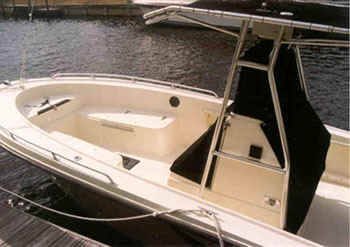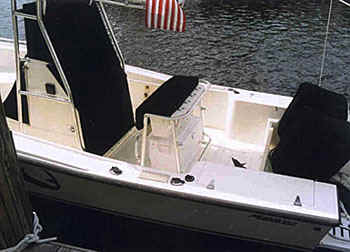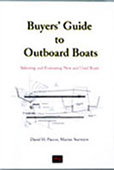Mako 221
1993
by David Pascoe
We get tons of requests for reviews on small boats. Problem is, you folks who buy them usually do so without surveys, so needless to say we don't see a lot of small boats. This one was for sale in a marina so we climbed about and took a look at it.
First, this is a tough, well built little boat. We bashed the hull sides, jumped on the decks, beat it with hammers, and concluded that there's a lot of fiberglass in this little booger. Its not fancy, not super high quality -- in fact the molding work on the hull was lumpy and flawed -- and is basically very utilitarian. The kind of boat most people should own because its not gonna go to rot and ruin quickly. Yes, it has that God-awful black rubber rub rail that's all distorted and uneven. But at least they bolted the hardware down and all the hatch and door hinges aren't falling off.
Nor did we get the impression that the deck was going to separate from the hull anytime soon. There were no stress cracks on the bottom or hull sides, and the dents and dings it had didn't poke holes in it. The transom was not bowed under the weight of a motor on a bracket. The internal hull access was not as good as we'd like, but what little we could see revealed no problems.
Oh, and for all you folks that got rotten deck cores because the center console is just screwed into the deck, this one has Starboard plastic battens bolted to the deck and the console is screwed to the Starboard (Starboard is that teflon-like slippery plastic that is very strong and impervious to UV.) Guess Mako got tired of paying warranty claims on their earlier models.
The deck has two very large removable plates -- that's for when your foamed in place aluminum tank bites the dust (or rather the salt water), so you don't have to cut the boat to pieces to get it out. There are other good reasons to have large deck plates, also.
This boat has got the aluminum transom bracket, but the paint finish is holding up fairly well and the thing is designed right with all the controls cables properly installed. No HOLES to let water in and sink the boat. Very considerate of them, no? Well, a lot of builders aren't that hip. Glub.
The cockpit doesn't have an adequate foot cove, meaning that the side liners are more or less straight up and down. That means its hard to lean over the side. And Mako is still installing the damn engine controls down low on the console on a ridiculous 45 degree angle. To advance the throttles I have to twist my wrist around until my hand faces forward, and lift from the most awkward position imaginable. This is a design fault that would really gall me. I want the controls in a nice, comfortable position. Meaning horizontal and up high.
I thought the hull vee was a bit on the shallow side, looking to be about 18 degrees at the transom. This doesn't look like an ideal rough water boat. Better for lakes and bays.
This is the kind of boat you can put on a trailer and store in the side yard darn near forever without having the thing crumble before your eyes. No frills, tough, utilitarian, easy to keep up because there's not much too it, and not much to go wrong. No upholstery, no teak, no wood, no aluminum, no die cast zinc alloy. Whoops, I misspoke: the bow rails are aluminum. In any case, a fairly decent little boat that should hold up well after a lot of beating and bashing. The four stars I give are not for style.
Posted July 21, 1998
Update: November 5, 1999 below
UPDATE: 11/5/99
The photos shown here are of a 1997 model 221 in which the cockpit layout has been significantly redesigned. I hadn't seen this year model before and it really caught my eye. The major changes are the two large in-gunwale fish-bait-storage boxes back aft, a full outboard motor well, a redesigned center console, and the seat-boxes up forward.


Personally, I do not like bracket mounts because they change the trim too much and allow the motors to be overtaken by the stern wave, often causing them to become submerged. That's definitely hard on the motors and your pocket book. So I was glad to see the return of the direct transom mount, despite the loss of cockpit space. Those very large side wells make the cockpit even smaller, but still, I'd rather have them than not. If you plan to go fishing with four people, you'll probably not agree with that, for this really makes it a two-person fish boat. On the other hand, I wouldn't want to go fishing with four people in any 22 footer, so the issue is moot in my view.
Whether you also like the two storage/seat boxes up front is a matter of preference. For the fishinfanatics, they can be a hindrance, but if you need lots of storage, well, then, you got it. Overall, you can see how these four boxes make for a very strong liner and hull sides. You don't have to worry about banging up against the pilings and cracking your gunwales in this boat. It is obviously very strongly built.
The trend continues with a notable lack of chintzy hardware. It's still got the big, black, ugly rubber rub rail that goes uneven over time, but it's better than aluminum. Speaking of which, the hand rails, T-top and bolster type seat are. The engine control surface mounting is STILL on a 45 degree angle, which makes the controls tough to work.
Notice also the new anchor/rope locker which is not a hatch in the deck as usual, but a much more convenient locker style arrangement that can double as a seat. Clever idea here.
Overall, it's still a rugged, solid little boat with some very worthwhile improvements.
Updated November 5, 1999
 Visit davidpascoe.com for his power boat books
Visit davidpascoe.com for his power boat books 














David Pascoe is a second generation marine surveyor in his family who began his surveying career at age 16 as an apprentice in 1965 as the era of wooden boats was drawing to a close.
Certified by the National Association of Marine Surveyors in 1972, he has conducted over 5,000 pre purchase surveys in addition to having conducted hundreds of boating accident investigations, including fires, sinkings, hull failures and machinery failure analysis.
Over forty years of knowledge and experience are brought to bear in following books. David Pascoe is the author of:
In addition to readers in the United States, boaters and boat industry professionals worldwide from nearly 80 countries have purchased David Pascoe's books, since introduction of his first book in 2001.
In 2012, David Pascoe has retired from marine surveying business at age 65.
On November 23rd, 2018, David Pascoe has passed away at age 71.
Biography - Long version